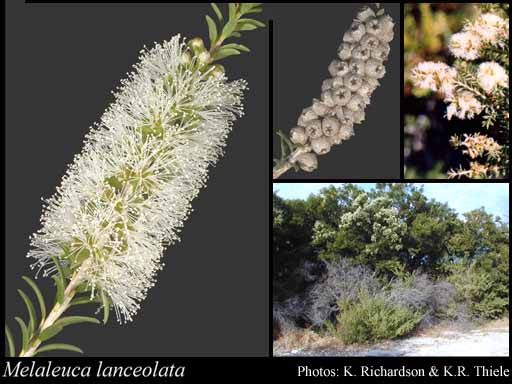- Reference
- Pl.Biol. 36 (1820)
- Conservation Code
- Not threatened
- Naturalised Status
- Mixed (Native in Part of Range, Naturalised Elsewhere)
- Name Status
- Current
Shrub or tree, 1-8 m high. Fl. white-cream, Jan to Sep. Limestone, clay or loam, brown or grey or white sand. Limestone ridges, coastal cliffs and dunes, salt flats, near salt lakes.

Distribution
- IBRA Regions
- Avon Wheatbelt, Coolgardie, Esperance Plains, Geraldton Sandplains, Hampton, Jarrah Forest, Mallee, Nullarbor, Swan Coastal Plain, Warren, Yalgoo.
- IBRA Subregions
- Eastern Goldfield, Eastern Mallee, Edel, Fitzgerald, Geraldton Hills, Hampton, Katanning, Lesueur Sandplain, Mardabilla, Merredin, Nullarbor Plain, Perth, Recherche, Southern Cross, Southern Jarrah Forest, Warren, Western Mallee.
- IMCRA Regions
- Central West Coast, Eucla, Leeuwin-Naturaliste, WA South Coast.
- Local Government Areas (LGAs)
- Albany, Augusta Margaret River, Busselton, Capel, Carnamah, Cockburn, Coolgardie, Coorow, Corrigin, Cranbrook, Dalwallinu, Denmark, Dundas, Esperance, Greater Geraldton, Irwin, Jerramungup, Kalgoorlie-Boulder, Kellerberrin, Kent, Kondinin, Kulin, Lake Grace, Mandurah, Manjimup, Melville, Merredin, Mount Marshall, Narembeen, Northampton, Nungarin, Perth, Ravensthorpe, Rockingham, Shark Bay, South Perth, Stirling, Swan, Trayning, Wanneroo, Waroona, Westonia, Wongan-Ballidu, Yilgarn.
Management Notes (for the Swan NRM Region)
General Biology. Growth form. Shrub/Small Tree. Reproduction. Seed. Dispersal. Wind, water. Vegetative regeneration strategy. Resprouts from base. Seedbank persistence. Short days-1 year. Fire response. Can resprout following fire. Seed is released from woody fruits in the canopy and mass germination occurs in the post fire environmant.
Notes. Has escaped from plantings and become established in bushland outside of its natural range.
Additional information. History of use/introduction. Garden escape, restoration plantings.
Suggested method of management and control. Hand pull seedlings. Cut and paint using 50% glyphosate. Read the manufacturers' labels and material safety data sheets before using herbicides. For further information consult the Australian Pesticides and Veterinary Medicines Authority to determine the status of permits for your situation or state.
Management Calendar
| Calendar Type | Jan | Feb | Mar | Apr | May | Jun | Jul | Aug | Sep | Oct | Nov | Dec | Comments |
|---|---|---|---|---|---|---|---|---|---|---|---|---|---|
| Flowering | Y | Y | Y | O | O | O | O | O | O | O | Y | Y | |
| Fruiting | Y | Y | Y | Y | Y | Y | Y | Y | Y | Y | Y | Y | |
| Optimum Treatment | Y | Y | Y | Y | Y | Y | Y | Y | Y | Y | Y | Y |
Legend: Y = Yes, regularly, O = Occasionally, U = Uncertain, referred by others but not confirmed.
References
- Brown, K. & Brooks, K. (2002) Bushland Weeds: A Practical Guide to their Management. Environmental Weeds Action Network, Greenwood.
- Hussey, B.M.J., Keighery, G.J., Dodd, J., Lloyd, S.G. & Cousens, R.D. (2007) Western Weeds. A guide to the weeds of Western Australia. 2nd Edition. The Plant Protection Society of Western Australia, Victoria Park.